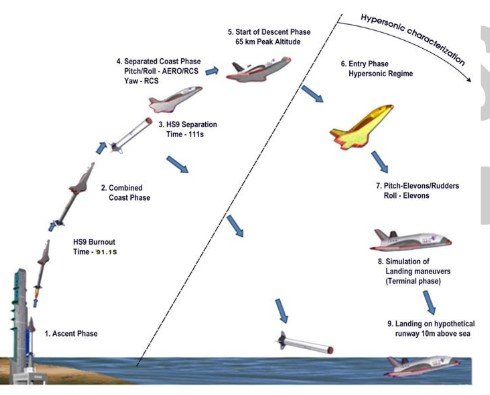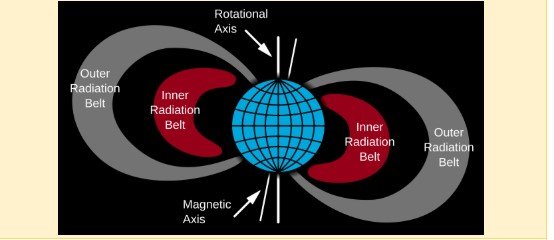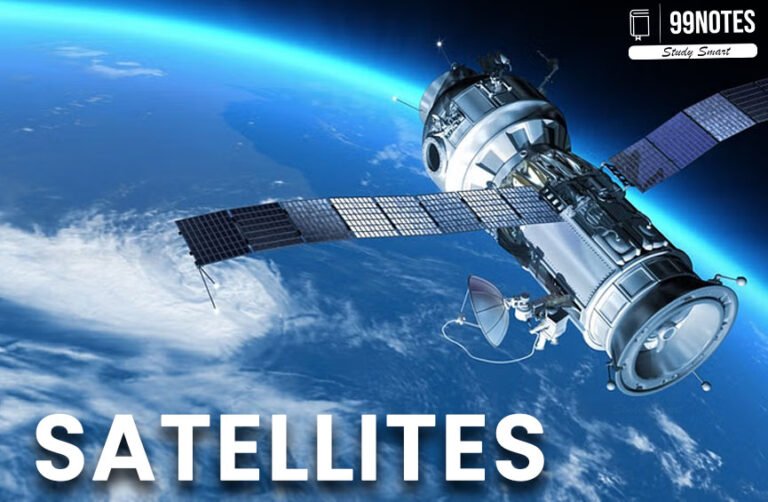Rockets
Rockets are vehicles that use external combustion engines (Jet propulsion) to accelerate without using any surrounding air. These work by generating an impulse by the high-speed ejection of the fuel mass.
- Apogee & Perigee:
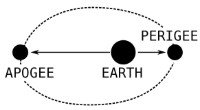
Types of Orbits:
- Posigrade: Along the motion of the earth.
- Retrograde: Opposite to the movement direction of the earth.
Low Earth orbit(LEO):
Low altitude of about less than 1000km. Its perigee can be as low as 30km. It has a high speed (above 7km/s). Thus satellites in this orbit can make more than 11 periods/day.
- Orbital Period: 84-127mintures.
- Below 160km due to friction rapid decay occurs.
- Beyond 600km 1st van Allen belts(which are a result of the interaction of solar winds with the earth’s magnetic field) occur which contain higher concentrations of charged particles and radiations. Thus the space stations and satellites are better placed below it.
Sun Synchronous orbit (SSO)
Sun Synchronous orbit is a nearly polar orbit. In this orbit, a satellite passes over a given point at the same given time daily. It lies in the low earth orbit region and is a subset of it.
| Van Allen Radiation Belts |
| The Van Allen radiation belt is a zone of energetic charged particles, most of which originate from the solar wind, that are captured by and held around a planet by that planet’s magnetosphere. Earth has two such belts, and sometimes others may be temporarily created. The belts are named after James Van Allen, who published an article describing the belts in 1958. |
Geosynchronous orbit:
An orbit in which the satellite passes above a point at least once a day. It forms a figure of ‘8’ in the sky to a static object on the ground. This is between the two Van-Allen belts.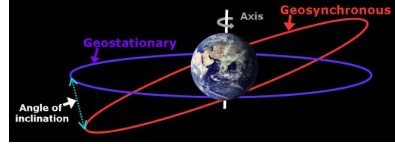
Geostationary Orbit (GSO):
It is a circular geosynchronous orbit at the altitude of 35,786 km (22,236 mi) above Earth‘s equator and following the direction of Earth’s rotation. An object in such an orbit appears motionless, at a fixed position in the sky, to ground observers.
- It is overhead at the equator.
- Communications satellites and weather satellites are often placed in geostationary orbits.
- Always Posigrade.
- Graveyard Orbit: 100km above Geostationary Orbit, where spent satellites are parked.
Geosynchronous transfer Orbit
Geosynchronous transfer Orbit or Geostationary transfer orbit(GTO) or Hoffman Transfer Orbit: used to reach geosynchronous or geostationary orbit(GSO) using high-thrust chemical engines. It has a very high apogee, which corresponds to geostationary altitude. Perigee occurs on or near the equator. Its period is 10.5 hours or so.
- Perigee: 190km & Apogee 36000km
Launchers of ISRO:
- M-100 Sounding Rockets: Initial experiments started with the establishment of the Thumba Equatorial Rocket Launching Station (TERLS) in 1963 at Thumba. The launch of the M-100 in November 1963, marked the beginning of the Indian Space Programme. This made it possible to probe the atmosphere in situ using rocket-borne instrumentation. The first rockets were two-stage rockets imported from Russia (M-100) and France (Centaure).
- Satellite launch Vehicle: SLV-3: successfully launched in 1980 from Sriharikota Range (SHAR), when Rohini satellite, RS-1, was placed in orbit, thereby making India the sixth member of an exclusive club of space-faring nations.
- The Augmented Satellite Launch Vehicle (ASLV) Programme was designed to augment the payload capacity to 150 kg, thrice that of SLV-3, for Low Earth Orbits (LEO). ASLV proved to be a low-cost intermediate vehicle to demonstrate and validate critical technologies, that would be needed for future launch vehicles like strap-on technology, inertial navigation, bulbous heat shield, vertical integration and closed loop guidance.

PSLV
PSLV stands for Polar Satellite Launch Vehicle. It is often referred to as the “Workhouse of the ISRO”, as
- Industry participation: 80%.
- It is an expendable launch system: It has different variants to cater to different mission requirements.
- It was developed to allow India to launch its Indian Remote Sensing (IRS) satellites into Sun-synchronous orbits, until the advent of the PSLV, which was commercially available only from Russia.
- PSLV can also launch small-size satellites into geostationary transfer orbit (GTO).
- Structure: The PSLV has four stages using solid and liquid propulsion systems alternately.
- The first stage, one of the largest solid rocket motors in the world, carries 138 tonnes of hydroxyl-terminated poly-butadiene urethane-bound (HTPB) propellant.
- Variants of PSLV: There are currently three operational versions of the PSLV —
- Standard (PSLV),
- Core-alone (PSLV-CA): without the six strap-on booster motors, and
- (PSLV-XL) version: carries more solid fuel in its strap-on motors than the standard version.
- PSLV 3S: See ‘Future plans’ given below on this page. [Lift off mass: 175Tonne only]
- PSLV DL(Dual Strap-ons): First flight: C44
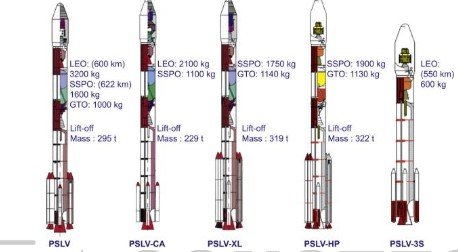
- Workhouse of ISRO: The PSLV has a near impeccable 44 successes in 47 flights and is a clear leader in the category of rockets that lift small satellites to low Earth orbits or LEOs.
- It was used in the launch of both Chandrayan and Mangalyan missions.
- 26 Sept’16: ISRO’s workhouse goes up. Puts the satellite in two orbits. PSLV C-35; Satellites:
- SCATSAT-1: 371 kg satellite for ocean and weather-related studies.
- It is a continuity mission for the Oceansat-2 scatterometer to provide wind vector data products for weather forecasting, cyclone detection and tracking services to the users.
- It carries a Ku-band scatterometer similar to the one flown on-board Oceansat-2.
- PRATAM (IIT-B) and PISAT(PES University, Bengaluru) from Indian academic institute.
- Three from Algeria: ALSATIN, 1B, 2B.
- Canada NLS-19 & US Pathfinder-1.
- Multiple burn Technology: Satellites put in two different orbits.
- SCATSAT-1: 371 kg satellite for ocean and weather-related studies.
- Jan’17: ISRO launches 104 satellites in one go, creates history; PSLV C-37;
- Took 1378kg payload;
- CARTOSAT-II: primary satellite. It is the 5th Cartosat in a series of Six.
- Launched two other Indian spacecraft, most of them IRS satellites.
- 101 foreign satellites from: 96 from the US, the rest from Israel, UAE, Netherlands, Kazakhstan & Switzerland.
- World Record: NASA launched 29 satellites in one go.
- The Indian PSLV has received more than double its normal share of inquiries from prospective customers ever since it launched a record 104 satellites in a single flight. ISRO is ramping up the availability of the PSLVs.
- At an altitude of 500km, the vehicle takes 90 minutes to complete one orbit. It accomplished the feat in 12 minutes. To ensure that satellites don’t collide, they were injected in pairs in opposite directions. Successive pairs were launched once the vehicle rotated by a few degrees, thereby changing the separation angle & time of separation.
- Took 1378kg payload;
- Apr’19: C-45: First 3 orbit mission; PLSV QL is a new variant with XL strap-on motors on the first stage.
- EMISAT: first satellite for gathering electronic intelligence(ELINT) to locate hostile radars for the military. 749km orbit.
- 28 satellites into a different 504km orbit.
- Then, the fourth stage will be restarted and guided to an altitude of 485km. This will serve as an orbital platform for space experiments. It’s the 3rd mission to use the fourth stage as a test bed. 3 experiments are aboard.
- IIST’s(Indian institute of space science and technology) Advanced Retarding Potential Analyser for Ionospheric Studies(ARIS). This is the first time that the IIST payload is aboard.
- Automatic Identification System (AIS), an ISRO payload for maritime satellite applications, and
- Automatic Packet Repeating System(APRS) is meant to assist amateur radio operators.
- Amateur radio Operators: someone who uses equipment at an amateur radio station to engage in two-way personal communications with each other in radio frequencies assigned to the amateur radio service. They are granted a licence by govt. Regulatory authority after passing an examination on applicable regulations, electronics, radio theory, and radio operation.
- It is PSLV’s longest mission(180 minutes).
KalamSat:
Stage 4 or PS4: 450kg PS4 takes the satellite to the last lap of desired height (anywhere between 400 km and 700 km.) Job done, it floats there for several years as space junk. Its weight is equal to two low weight satellite. A full test satellite of that size can cost around ₹200 crore.
The revived stage of the PSLV-C44 flight would be equipped with solar power systems to keep it working and monitored from ground. This will make PS4 an experimental platform to do technology demonstrations and experiments by agencies & students until it disintegrates naturally.
The trial with the expired fourth rocket stage would easily be the first of its kind by any space agency. It would show PS4 as a unique cost-saving test bed for new technologies.
GSLV
GSLV stands for Geosynchronous Satellite Launch Vehicle, nicknamed the Naughty Boy of ISRO due to the couple of failures that ISRO faced during its development. It turned into an adorable boy in 2016 when we successfully completed all of its development tests.
- Industry participation is 85-90% in GSLV Mk III.
- Three stages: All 2.8m in dia.
- First stage: Solid. S125, S149, S200(3rd biggest solid motor in the world) etc.
- Second stage: Liquid: Vikas Engine: L110. (Nitrogen Tetroxide N2O4)
- Cryogenic Upper stage: Uses LOX & LH2: For example, C25, C30(in development)
- Developed at Liquid Propulsion System Centre in Valiamala(Kerala) and Mahendragiri(TN).
- Maintaining structural & thermal integrity of the engine at very high temperatures during combustion just a few centimetres away from -250oC material behaves differently at this temp.]
- Igniting cryogenic fuel and sustaining the combustion for a prolonged period.
- It has the highest specific impulse than other stages. It is difficult to use Cryogenic in all stages.
- India is one of 6 countries that have indigenously produced the Cryogenic stage.
- Variants: Two types of flight:- D(development flight), F(Operational flight)
- GSLV Mk-I: Using Russian Cryogenic Stage.
- Only two flights were successful: D2, and F01. Thus development halted
- Naughty boy: D1(failed), F02(destroyed), F04(reached with minor inclination error).
- GSLV Mk-II can lift payloads of 2500 kg[payload to LEO 5000kg].
- D3(failed), F06(destroyed).
- Developmental Flights:
- GSLV D5: Tested Cryogenic Upper State(CUS) developed by India indigenously. 5 Jan 2014.
- GSLV D6: put GSAT-6 into GTO.
- Operational Flights:
- GSLV F05: 8th Sept’16: GSLV – F05: 1st operational GSLV flight equipped with CUS and the fourth to carry the indigenous CUS. 2,211kgPayload put with Extreme precision: Perigee within 300m(0.18%) & apogee of 80km(0.2%), inclination(about 0%) in GTO.
- Payload: INSAT-3DR: advanced atmospheric satellite for advanced weather forecasting.
- It’ll take Earth’s image every 26 min & focus on sea surface temperature, snow cover, winds etc. as an advanced atmospheric satellite.
- It carries a satellite-aided Search and Rescue Transponder that picks up and relays alert signals originating from distress beacons of maritime, aviation and land-based users. The Indian service region will also include Bangladesh, Bhutan, Maldives, Nepal, Seychelles, Sri Lanka and Tanzania for providing distress alert services.
- The major users of the service will be the Indian Coast Guards, Airports Authority of India (AAI), Directorate General of Shipping, Defence Services and fishermen.
- Payload: INSAT-3DR: advanced atmospheric satellite for advanced weather forecasting.
- GSLV F09: March’18: puts GSAT 9: SAARC satellite: Has 12 Ku-Band transponders.
- It provides crucial information on telemedicine, tele-education, banking and television broadcasting opportunities.
- It is also equipped with remote sensing technology which enables the collection of real-time weather data and helps in observations of the geology of the South Asian nations.

- GSLV F05: 8th Sept’16: GSLV – F05: 1st operational GSLV flight equipped with CUS and the fourth to carry the indigenous CUS. 2,211kgPayload put with Extreme precision: Perigee within 300m(0.18%) & apogee of 80km(0.2%), inclination(about 0%) in GTO.
- GSLV Mk-III: can lift a payload of around 4000kg. GSLV Mk-III (or Launch Vehicle Mark 3 – LMV 3) will make ISRO truly independent: not having to rely on facilities abroad for launching heavier payloads.
- 2014: Sub-orbital development flight test: Re-entry experiment tested:
- Two S-200 Solid motor(200T) strapons. It is the world’s 3rd biggest solid motor.
- L110 core Liquid motor(110T): Two powerful Vikas engines.
- Jan 2017: C-25 Cryogenic stage(25T) test fired.
- D1 & D2 planned to put versions of GSAT(more than 3.5Tonne)
- GSLV Mk III D1: Jun’17: successfully launched to put 3.2Tonne INSAT-19 or GSAT-19.
- India’s first fully functional rocket to be tested with a Cryogenic Engine.
- GSLV Mk III D2: Nov’18: 4 Tonne GSAT 29: For JK & North East to boost communication by high throughput connectivity. This marks the rocket as operational.
- GSLV Mk III D1: Jun’17: successfully launched to put 3.2Tonne INSAT-19 or GSAT-19.
- The operational flight would put Chandrayan II & Gaganyan.
- 2014: Sub-orbital development flight test: Re-entry experiment tested:
FUTURE PLANS
PSLV 3S
Small Satellite Launch Vehicle(SSLV):
Also known as the PSLV 3s is proposed a demonstration launch in 2018.
- Being developed at VSSC, would lift satellites up to 500-600kg in LEO. [Lift off mass: 175 Tonne only]
- PSLV-3S was conceived as a three-staged version of PSLV with its six strap-on boosters and second liquid stage removed.
- Today it takes 300+ engineers and about 40 days to assemble a PSLV. A small launcher can be set up in 3 days by a small team.
- Currently for one satellite operators wait for up to two years.
- It would reduce costs. Probably ninth or tenth of the present cost.
- It is estimated by the Euroconsult that 6200 smallsats – many of them constellations – would be launched during 2017-2026 & touch a market value of $30bn – up from $8.9bn.
Next Generation Launch Vehicle (NGLV)
The Next Generation Launch Vehicle (NGLV) is a rocket system being developed by ISRO to replace current launch vehicles. The NGLV is a three-stage, partially reusable heavy-lift launch vehicle that will have a payload capacity of 30 tonnes to Low Earth Orbit (LEO).
The NGLV is designed to support India’s space exploration goals, including:
- Establishing and operating the Bharatiya Antariksh Station (Indian Space Station)
- Achieving a crewed lunar landing by 2040
- Launching human spaceflight missions
- Launching communication and earth observation satellite constellations
This plan was earlier dubbed as the Unified Launch Vehicle (ULV): is a development project whose core objective is to design a modular architecture that could eventually replace the PSLV, GSLV Mk I/II and LVM3(Launch Vehicle Mk-III) with a single family of launchers.
- It’ll have a Semi-Cryogenic core (SC160) & Cryogenic upper stage (CE30 using CE20 engine).
- SC 160 Semi-cryogenic: being developed at Liquid Propulsion Systems Centre, Mahendragiri.
- It will use 160 Tonnes of space grade Kerosene (Fuel) & liquid oxygen (Oxidiser).
- By 2018: flight capability would be developed; It would be tested on GSLV Mk-III(or LVM3). This would boost LVM3’s lifting capability from 4 Tonnes to 6 Tonnes.
- CE 20 Cryogenic Engine: 1st Indian engine with gas generator cycle.[CE30 Stage]
- Tested on Development flight. Could be used for the Chandrayaan II mission.
- SC 160 Semi-cryogenic: being developed at Liquid Propulsion Systems Centre, Mahendragiri.
- Heavy Launch Vehicle(HLV): by 2020: When suitably fitted into a launch vehicle, SC160 will soon put India into class 6T to 10T to geostationary transfer orbit(GTO).
- Super heavy launch Vehicle(SHLV): This would be enhanced to 15T by putting strap-ons in clusters – the stage where major EU & US launch providers are.
New Fuels
India aims to use Green Propellant for future missions. ISRO seeks to replace the Hydrazine fuel. It is a highly toxic and carcinogenic chemical. Initial tests at LPSC (Liquid System Propulsion Centre); using HAN (Hydroxylammonium Nitrate).
- It’s a monopropellant. It doesn’t need a separate Oxidiser.
- It is used extensively in satellite thrusters for orbital correction & Orientation control.
New Engines:
Solution of High Cost. Air Breather Engines: Using atmospheric oxygen by making.
Ramjet Technology:
[Used in Brahmos missile] It uses the Vehicle’s forward motion to compress incoming air for combustion without a rotating compressor. Fuel is injected into the combustion chamber where it mixes with the hot compressed air and ignites.
- For efficient working speeds around Mach 1 is required. It requires an assisted take-off like a rocket assist to accelerate it to a speed where it begins to produce thrust.
- It can operate up to the speeds of Mach 4. Its efficiency starts to drop at Hypersonic speeds. i.e. its specific impulse decreases.
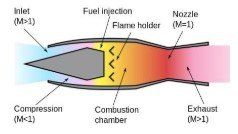
Scramjet Technology:
It is an improvement over the Ramjet engine; It operates at hypersonic speeds and allows hypersonic combustion.
- This is a Dual Mode Ramjet: Where the Ramjet transforms into a scramjet; It can work both in supersonic and subsonic modes.
- Aug’16: ISRO’s Air Breathing Propulsion Project(ABPP) was successfully flight tested. It uses Hydrogen as fuel and atmospheric air as the oxidiser.
- Critical technologies such as the ignition of air-breathing engines at supersonic speed, holding the flame at supersonic speed, air intake mechanism and fuel injection systems have been successfully demonstrated.
- It was a short-duration experimental test of the Scramjet engine with a hypersonic flight at Mach 6. ISRO’s Advanced Technology Vehicle (ATV), which is an advanced-sounding rocket, was the solid rocket booster used for this recent test of Scramjet engines at supersonic conditions. ATV-carrying Scramjet engines weighed 3277 kg at lift-off.
Note: Jet Engines can be following 4 kinds (Along with their specific impulse).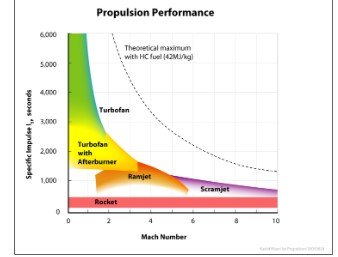
Turbofan is generally used in commercial flights & Turbojets in Fighter jets.
Reusable Launch Vehicle-Technology Demonstrator (RLV-TD):
Mainly designed for Vyomnauts re-entry. It is India’s first winged-body aerospace vehicle operating in a hypersonic flight regime.
- Winged RLV-TD has been configured to act as a flying test bed to evaluate various technologies, namely, hypersonic flight, autonomous landing and powered cruise flight.
- In future, this vehicle will be scaled up to become the first stage of India’s reusable two-stage orbital launch vehicle.
- RLV-TD consists of a fuselage (body), a nose cap, double delta wings and twin vertical tails. It also features symmetrically placed active control surfaces called Elevons and Rudder.
- This technology demonstrator was boosted to Mach 5 by a conventional solid booster (HS9) designed for a low burn rate.
- Objectives of RLV-TD:
- Hypersonic aero thermodynamic characterisation of wing body
- Evaluation of autonomous Navigation, Guidance and Control (NGC) schemes
- Integrated flight management
- Thermal Protection System Evaluation
- Achievements:
